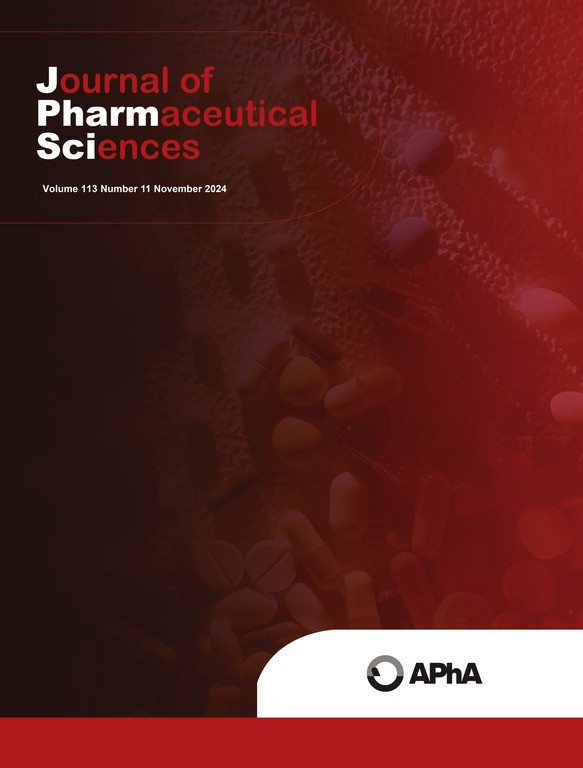Metal-induced oxidation of polysorbate 80 in the presence of hydrogen peroxide: mechanistic studies
IF 3.7
3区 医学
Q2 CHEMISTRY, MEDICINAL
引用次数: 0
Abstract
Polysorbate 80 (PS80) is a commonly used surfactant in protein formulations and is highly susceptible to oxidative degradation. Here, we present mechanistic studies on metal-induced PS80 oxidation in the presence of hydrogen peroxide in acetate buffer. A total of 12 pharmaceutically relevant metal ions were tested, including Mn(II), Cu(II), Cu(I), Mg(II), Zn(II), Ca(II), Al(III), Pb(II), Sn(II), Co(II), Fe(III), Ni(II) and W(IV). The overall PS80 degradation was monitored by a fluorescence micelle assay (FMA) and the oxidation products were characterized by mass spectrometry (MS). Three metal ions, Cu(II), Co(II), and Fe(III), induced significant PS80 degradation and solutions containing these ions were subjected to further mechanistic studies. The extent of oxidation was dependent on both metal and peroxide concentrations. PS80 degradation catalyzed by Cu(II) and Co(II) was completely prevented by 250 µM and 500 µM ethylenediaminetetraacetic acid (EDTA), but only partially inhibited when catalyzed by Fe(III). The role for superoxide radical anion in the initiation of PS80 oxidation was examined by addition of Cu,Zn superoxide dismutase (SOD). The potential of the metal ions to generate free radicals was monitored with the spin trap 5,5-dimethyl-1-pyrroline N-oxide (DMPO), followed by LC-MS analysis. Degradation mechanisms, particularly the initiation of the oxidation chain reactions, are discussed for each metal.
过氧化氢存在下金属诱导的聚山梨酸80氧化:机理研究
聚山梨酯80 (PS80)是蛋白质配方中常用的表面活性剂,极易氧化降解。在这里,我们提出了在醋酸缓冲液中过氧化氢存在下金属诱导PS80氧化的机制研究。共检测了12种与药物相关的金属离子,包括Mn(II)、Cu(II)、Cu(I)、Mg(II)、Zn(II)、Ca(II)、Al(III)、Pb(II)、Sn(II)、Co(II)、Fe(III)、Ni(II)和W(IV)。采用荧光胶束法(FMA)监测PS80的整体降解情况,并用质谱法(MS)对氧化产物进行表征。三种金属离子,Cu(II), Co(II)和Fe(III),诱导PS80的显著降解,并对含有这些离子的溶液进行了进一步的机制研究。氧化的程度取决于金属和过氧化物的浓度。250µM和500µM乙二胺四乙酸(EDTA)完全阻止Cu(II)和Co(II)对PS80的催化降解,而Fe(III)对PS80的催化降解仅部分抑制。通过添加Cu,Zn超氧化物歧化酶(SOD)研究了超氧自由基阴离子在PS80氧化起始中的作用。用自旋阱5,5-二甲基-1-吡咯啉n -氧化物(DMPO)监测金属离子产生自由基的电位,然后用LC-MS分析。讨论了每种金属的降解机制,特别是氧化链反应的引发。
本文章由计算机程序翻译,如有差异,请以英文原文为准。
求助全文
约1分钟内获得全文
求助全文
来源期刊
CiteScore
7.30
自引率
13.20%
发文量
367
审稿时长
33 days
期刊介绍:
The Journal of Pharmaceutical Sciences will publish original research papers, original research notes, invited topical reviews (including Minireviews), and editorial commentary and news. The area of focus shall be concepts in basic pharmaceutical science and such topics as chemical processing of pharmaceuticals, including crystallization, lyophilization, chemical stability of drugs, pharmacokinetics, biopharmaceutics, pharmacodynamics, pro-drug developments, metabolic disposition of bioactive agents, dosage form design, protein-peptide chemistry and biotechnology specifically as these relate to pharmaceutical technology, and targeted drug delivery.

 求助内容:
求助内容: 应助结果提醒方式:
应助结果提醒方式:


